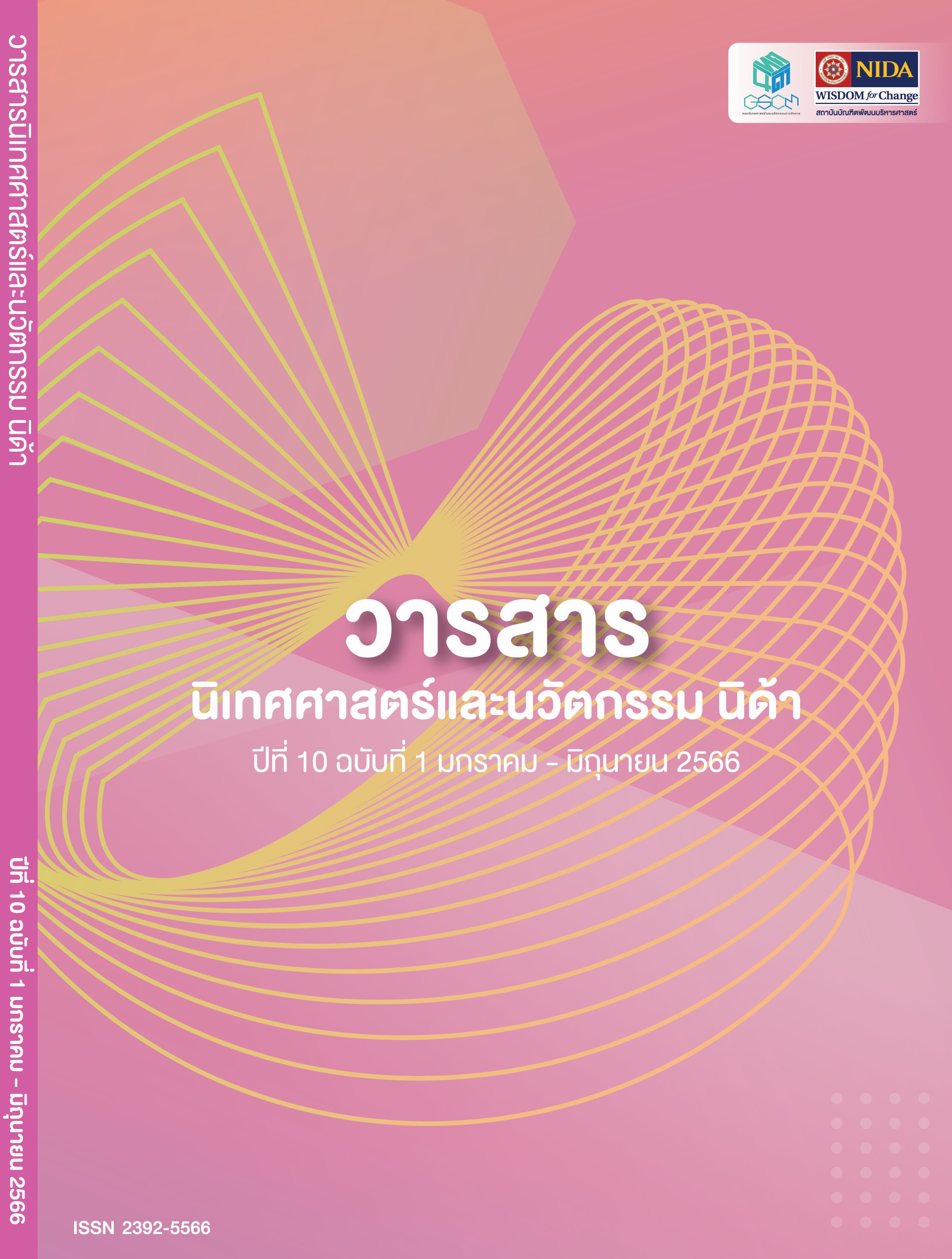Cooperative Learning to Foster Creativity through Digital Storytelling
Main Article Content
Abstract
This article aimed to introduce the method of the digital storytelling process. Combined with cooperative learning, there are five steps: the first step is to clarify the objectives. Step 2: Provide information. Step 3: Group activities. Step 4: Review and test. Step 5: Summarize the course and provide support. When students engage in collaborative learning processes that combine digital storytelling, it provides them with creative skills, including 1) Originality, 2) flexibility, 3) Fluency 4) Elaboration and equips them with the skills to understand and use digital technology to maximize the use of tools, equipment, and digital technology for communication, operations, and collaboration.
Article Details

This work is licensed under a Creative Commons Attribution-NonCommercial-NoDerivatives 4.0 International License.
ข้อความและความเห็นในวารสารนิเทศศาสตร์และนวัตกรรม นิด้า เป็นของผู้เขียนแต่ละท่าน มิใช่ของคณะนิเทศศาสตร์และนวัตกรรมการจัดการ สถาบันบัณฑิตพัฒนบริหารศาสตร์
References
กระทรวงศึกษาธิการ. (2565). นโยบายและจุดเน้นของกระทรวงศึกษาธิการ ประจำปีงบประมาณ พ.ศ. 2567. https://drive.google.com/drive/folders/1BV_r9HmBwIHNde2Xs7GKlkNGW7QA11G8
เกียรติอนันต์ ล้วนแก้ว. (2559). เมื่อ Thailand 4.0 ถูกขับเคลื่อนด้วย Education 2.0. สานปัญญา. 26.
พัชรา วาณิชวศิน. (2562). เทคนิคการเล่าเรื่อง: เครื่องมือสอนที่มีศักยภาพ. วารสารครุศาสตร์อุตสาหกรรม, 18(3). 281-291.
เรวดี ศรีสุข. (2562). การประยุกต์ใช้ทฤษฎีการเรียนรู้แบบร่วมมือ (Co-operative learning) ในการออกแบบจัดการเรียนการสอน. The Journal of Boromarjonani College of Nursing Suphanburi, 2(1). 5-16.
วลักษณ์สุภา พึ่งผล. (2560). การใช้เรื่องเล่าในการพัฒนาทักษะการขาย. มหาวิทยาลัยธรรมศาสตร์, กรุงเทพฯ.
ศุภวรรณ์ เล็กวิไล. (2540). “การเรียนแบบร่วมมือ”. เอกสารการเสวนาทางวิชาการครั้งที่ 3: การพัฒนาการเรียนการสอนแนวใหม่ 29 ธันวาคม 2540. หอประชุมกรมสามัญศึกษา กรุงเทพมหานคร.
สำนักงาน ก.พ. (2559). หนังสืออิเล็กทรอนิกส์ การคิดเชิงสร้างสรรค์. https://www.ocsc.go.th/sites/ default/files/ document/ocsc-2017-eb13.pdf
สุวิทย์ มูลคำ. (2547). กลยุทธ์การสอนสังเคราะห์ (พิมพ์ครั้งที่2). ภาพพิมพ์.
อาภรณ์ ใจเที่ยง. (2550). หลักการสอน (ฉบับปรับปรุง). (พิมพ์ครั้งที่ 4). โอเดียนสโตร์.
Arends, J. (1989). Syntactic developments in Sranan: Creolization as a gradual process. Journal of Pidgin and Creole Languages, 6(1), 127-133. https://doi.org/10.1075/ jpcl.6.1.11kou
Benmayor, R. (2008). Digital storytelling as a signature pedagogy for the new humanities. Arts Humanit High Education, 7(2), 188-204. https://doi.org/10.1177/147402220808864
Glen Bull and Sara Kajder. (2004). Digital storytelling in the Language Arts classroom. Learning & Leading with Technology, 32(4). https://files.eric.ed.gov/fulltext/EJ697294.pdf
Grant & Bolin. (2016). Digital storytelling: A method for engaging students and increasing cultural competency. The Journal of Effective Teaching, 16(3), 44-61. https://www.research gate.net/publication/312146702_Digital_Storytelling_A_Method_for_Engaging_Students_and_Increasing_Cultural_Competency
Gregori Signes. (2008, June 15). Practical uses of digital storytelling. http://www.uv.es/~ gregoric/DIGITALSTORYTELLING/DS_files/DST_15_ene_08_final.pdf
Guilford, J.P. (1956) The structure of intellect. Psychological Bulletin, 53, 267-293. http://dx.doi.org/10.1037/h0040755
Johnson, D. W.; Johnnon, R.T. and Holubec, E. J. (1994). The nuts and bolts of cooperative learning. Interaction Book Company.
Kapp, K. M. (2012). The gamification of learning and instruction. Wiley.
Karakoyun & Yapıcı. (2016). Use of digital storytelling in Biology teaching. Universal Journal of Educational Research, 4(4), 895-903. https://doi.org/10.13189/ujer.2016.040427
Lambert, J. (2007) Digital storytelling cookbook (2 ed.). Digital Diner Press.
Lambert, J. (2010) Cookbook for digital storytelling. Digital Diner Press.
Meadows, D. (2003). Digital storytelling: Research-based practice in new media. Visual Communication, 2(2), 189-193. https://doi.org/10.1177/147035720300200200
Morra, S. (2013, June 5). 8 Steps to great digital storytelling. Samantha Morra. https://samantha morra.com/2013/06/05/edudemic-article-on-digital-storytelling/
Ohler. (2013). Digital storytelling in the classroom: New media pathways to literacy, learning, and creativity. Corwin.
Osborn, A. F. (1957). Applied imagination. Charles Scribners.
Rebecca J. Morris. (2011) Responses of listener-viewers in digital storytelling: Collaborations in the intermediate classroom and the middle school library. (Unpublished doctoral dissertation) University of Pittsburgh. http://d-scholarship.pitt.edu/9031/
Robin, B. (2006). The educational uses of digital storytelling. In C. Crawford et al. (Eds.), Proceedings of Society for Information Technology and Teacher Education International Conference 2006 (pp. 709-716). Chesapeake, VA: AACE. https://www.scirp.org/(S(351jmbntvnsjt1aadkposzje))/reference/ReferencesPapers.aspx?ReferenceID=1644250
Robin, B. R. (2006). The educational uses of digital storytelling. http://digitalliteracyinthe classroom.pbworks.com/f/Educ-Uses-DS.pdf
Robin, B. R. (2016). The power of digital storytelling to support teaching and learning. Digital Education Review, 30, 17-29. https://files.eric.ed.gov/fulltext/EJ1125504.pdf
Slavin. Robert E. (1987). Cooperative learning and cooperative school. Educational Leadership.
Torrance, E. P. (1962). Guiding creative talent. Englewood Cliffs, Prentice-Hall, Inc. http://dx.doi.org/10.1037/13134-000
Wallach, M. A., & Kogan, N. (1965). A new look at the creativity-intelligence distinction. Journal of Personality, 33(3), 348–369. https://doi.org/10.1111/j.1467-6494.19 65.tb01391.x
Wheeler, C. (1990). Public workshop: Cooperative learning. (Phonotype) Lecture given at Chulalongkorn University, 19 December.
Yang, Y.-T. C., & Wu, W.-C. I. (2012). Digital storytelling for enhancing student academic achievement, critical thinking, and learning motivation: A year-long experimental study. Computers & Education, 59(2), 339-352. http://dx.doi.org/10.1016/jcompedu .2011.12.12


